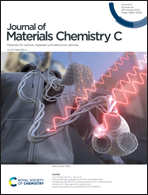Cr3+-Free near-infrared persistent luminescence material LiGaO2:Fe3+: optical properties, afterglow mechanism and potential bioimaging†
Abstract
Near-infrared (NIR) persistent luminescence (PersL) materials have recently evoked considerable interest in the field of biomedicine, but the choices of efficient emitters for NIR PersL phosphors are rather limited. Herein, we report a new class of Fe3+-activated NIR PersL phosphor based on the LiGaO2 host, which exhibits an intense NIR PersL at around 748 nm and possesses an ultra-long PersL time of much longer than 26 h. The optical properties of this phosphor as well as the trapping and de-trapping processes, the trap characteristics, and the underlying PersL mechanism are comprehensively studied by means of photoluminescence (PL), PersL, electron paramagnetic resonance (EPR), thermoluminescence (TL), and X-ray photoelectron spectroscopies (XPS). It was found that the NIR PersL in this material is closely related to the oxygen vacancies. Furthermore, the penetration experiments and cytotoxicity tests of the biological tissue show that this material has great potential for bioimaging applications. Our achievement in the case of nontoxic Fe3+-activated LiGaO2 phosphors lays the foundation for the future design of Cr3+-free PersL phosphors with efficient NIR PersL towards versatile bioapplications.



 Please wait while we load your content...
Please wait while we load your content...